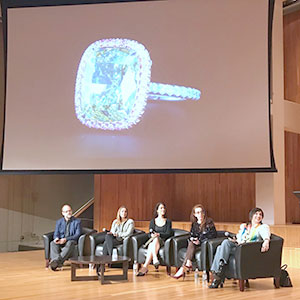
After taking in the Met exhibit on Tuesday, my next New York City Jewelry Week stop was a panel discussion held at the Fashion Institute of Technology (FIT) titled “Making Your Breaks in Fine Jewelry: Digital Edition.”
The all-female panel, moderated by Elisabeth Austin, diamantaire and creative director of DiamondRunway.com, included Melissa Dusenberry, creator of AlltheBrilliants.com; jewelry designer Wendy Brandes (who also authors a popular blog); gemologist, consultant, and blogger Erica Silverglide (aka @gemologygeek); and Catherine Cason, founder of the media brand @gem_hunt and its companion retail platform @gembreakfast.com.
Kim Nelson, chair of the Jewelry Design department at FIT, was also on hand to weigh in on how the future of fine jewelry contains opportunities for new creatives.
Though the talk was aimed at those hoping to chart a similar career path as the panelists, whether it was designing a successful fine jewelry line, cultivating a robust social media following, or producing compelling content, there were a number of comments to intrigue (provoke?) industry pros at all levels.
Such as:
Product moves on Instagram
“We see the most reward for our efforts when we work with a designer to create a custom showpiece and bring people along on the designer and maker’s journey,” said Catherine Cason (get to know more about her brand through this thoughtful interview by JCK’s Brittany Siminitz). “When people see how much work and love goes into creating the design, I can sell a $5,000 ring in 30 seconds on Instagram. “
Phone calls are classy
“Personal attention is part of the luxury experience,” said Wendy Brandes. “Retailers should not be afraid to pick up the phone to call a great customer and say, ‘I have something here just for you.’ I think that old-fashioned outreach, that old-school salesmanship is still vital. You can’t do everything online and via text, you’ve got to pick up the phone.”
Less is more
“So many designers are so creative that they can’t see that if you remove pieces and focus on details and beautiful stones to create maybe 10 pieces instead of 30, it’s better for your margins and you’ll have a collection that’s more cohesive,” said Erica Silverglide (here’s a short list of some of her favorite stone dealers, revealed in my interview with her ahead of JCK Tucson 2018).
You can’t build a brand without a network of peers
“We are in a very interesting place right now,” said Melissa Dusenberry. “Women really are helping women, and I would say over the last the two years this [practice] has gotten more powerful. Not being afraid to say you don’t know something and reaching out to someone who does is key. Then you will have a fantastic group of women who are supportive of you and enthusiastic about what you’re doing.”
CAD is bad…but also good
“You can learn to create a very sophisticated product digitally quite quickly, but an argument can be made that computer technology is eroding design craftsmanship because it’s become the jewelry industry’s express key, its push-button product,” said Kim Nelson. “[Though you need to learn the program,] avoid being identified by the computer and know whether you are a creative or a technician. If you’re going to be a [CAD] technician, make sure you know how to make jewelry. Make sure you understand the product, because you are going to be at the front line of production problems.”
The industry needs more makers
“There’s an urgent need for people who can do the work by hand,” said Brandes. “We need people who are great setters and great wax cutters, because there’s a swing back to [jewelry design made with a] human touch.”
Top, from left: “Making Your Breaks in Fine Jewelry: Digital Edition” speakers Kim Nelson, Catherine Cason, Melissa Dusenberry, Erica Silverglide, and Wendy Brandes (not pictured: moderator Elisabeth Austin)
Follow me on Instagram – @aelliott718
- Subscribe to the JCK News Daily
- Subscribe to the JCK Special Report
- Follow JCK on Instagram: @jckmagazine
- Follow JCK on X: @jckmagazine
- Follow JCK on Facebook: @jckmagazine